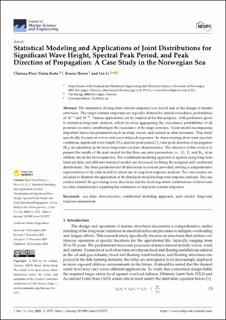| dc.contributor.author | Serta, Clarissa Pires Vieira | |
| dc.contributor.author | Haver, Sverre Kristian | |
| dc.contributor.author | Li, Lin | |
| dc.date.accessioned | 2024-03-26T11:47:48Z | |
| dc.date.available | 2024-03-26T11:47:48Z | |
| dc.date.created | 2024-01-15T14:28:47Z | |
| dc.date.issued | 2023 | |
| dc.identifier.citation | Pires Vieira Serta, C., Haver, S., & Li, L. (2023). Statistical Modeling and Applications of Joint Distributions for Significant Wave Height, Spectral Peak Period, and Peak Direction of Propagation: A Case Study in the Norwegian Sea. Journal of Marine Science and Engineering, 11(12), 2372. | en_US |
| dc.identifier.issn | 2077-1312 | |
| dc.identifier.uri | https://hdl.handle.net/11250/3124214 | |
| dc.description.abstract | The estimation of long-term extreme response is a crucial task in the design of marine structures. The target extreme responses are typically defined by annual exceedance probabilities of 10-2 and 10-4. Various approaches can be employed for this purpose, with preference given to statistical long-term analysis, which involves aggregating the exceedance probabilities of all potential sea states contributing to the exceedance of the target extremes. A joint model encompassing important metocean parameters such as wind, waves, and current is often necessary. This study specifically focuses on waves and wave-induced responses. In characterizing short-term sea state conditions, significant wave height (Hs), spectral peak period (Tp) and peak direction of propagation (phi p) are identified as the most important sea state characteristics. The objective of this work is to present the results of the joint model for the three sea state parameters, i.e., Hs, Tp and phi p, at an offshore site in the Norwegian Sea. The conditional modeling approach is applied using long-term hindcast data, and different statistical models are discussed for fitting the marginal and conditional distributions. The fitted parameters for all directional sectors are provided, offering a comprehensive representation of the joint model for direct use in long-term response analysis. Two case studies are included to illustrate the application of the fitted joint model in long-term response analyses. The case studies identify the governing wave directions and the most important combinations of short-term sea state characteristics regarding the estimation of long-term extreme responses. | en_US |
| dc.language.iso | eng | en_US |
| dc.publisher | MDPI | en_US |
| dc.rights | Navngivelse 4.0 Internasjonal | * |
| dc.rights.uri | http://creativecommons.org/licenses/by/4.0/deed.no | * |
| dc.title | Statistical Modeling and Applications of Joint Distributions for Significant Wave Height, Spectral Peak Period, and Peak Direction of Propagation: A Case Study in the Norwegian Sea | en_US |
| dc.type | Peer reviewed | en_US |
| dc.type | Journal article | en_US |
| dc.description.version | publishedVersion | en_US |
| dc.rights.holder | The authors | en_US |
| dc.subject.nsi | VDP::Teknologi: 500::Marin teknologi: 580 | en_US |
| dc.source.volume | 11 | en_US |
| dc.source.journal | Journal of Marine Science and Engineering | en_US |
| dc.source.issue | 12 | en_US |
| dc.identifier.doi | 10.3390/jmse11122372 | |
| dc.identifier.cristin | 2226752 | |
| cristin.ispublished | true | |
| cristin.fulltext | original | |
| cristin.qualitycode | 1 | |

